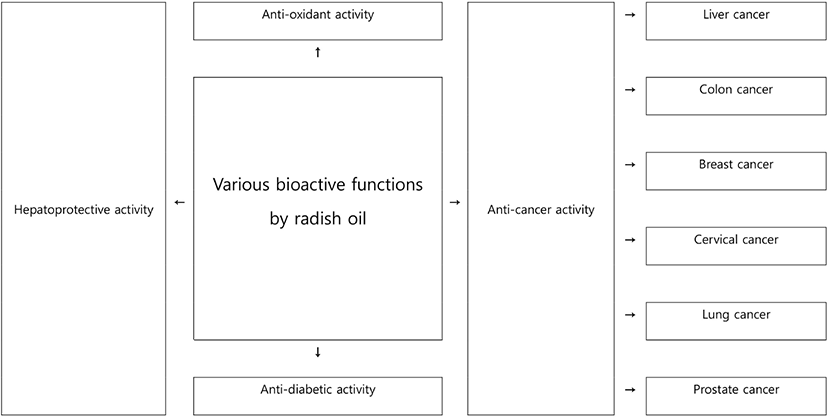Introduction
Radish, a species belonging to the genus Raphanus, is widely known as Raphanus sativus L. [1,2]. In general, radish was recognized as a root because of its specialized structure (hypocotyls) which had a partial and(or) full subterranean habitat [2,3]. And its shape was relevant to the true roots, and it could keep starch and other compounds [3]. The color of radish’s skin ranged widely from white in Asia to red, purple green and black in Europe [1,2]. However, the flesh of radish produced in most of Europe and Asia was mostly white [2,4].
In general, it was known that the properties of radish were owing to its phytochemical amounts [2]. Also, the red color of radish roots was found to be due to anthocyanin pigments [1,2]. And radishes, which were more likely to form isothiocyanates, could contribute a lot to their pungency and distinctive taste [1,2]. In particular, countries such as Hawaii, Japan and the Philippines have a high tendency to consume these radishes [1,2]. The edible part of radish by humans was mostly the root, and in recent years, consumption of leaves and sprouts has also increased rapidly [5,6]. In Asia, radish root was most commonly consumed, and was mainly processed by drying or canning and pickling [6]. As a specific example, the leaves and shoots are commonly consumed raw as part of a salad [2]. This is because radishes are low in calories [7]. Furthermore, radishes were also widely known as good sources of calcium, copper, folic acid, magnesium, manganese, potassium, vitamin B6, vitamin C, and so on [2,7].
Grounded on data of the European Prospective Investigation into Cancer and Nutrition (EPIC) cohort, the consumption of radish by Europeans ranked fifth, accounting for approximately 6% of all cruciferous or Brassicaceae vegetables [8]. Looking at the order, 1st place was cauliflower, 2nd place was broccoli, 3rd place was white cabbage, and 4th place was regular cabbage [8]. According to what is known so far, radish extract was used to treat various organ disorders in humans [2,4,6]. In particular, many studies have been conducted on radish extract as a source of physiologically active compounds that have health effects as well as clinical effects in diseases such as high blood pressure and heart metabolic disorders in humans [9]. In addition, there is a growing interest in the use of radish extracts as antibacterial and antioxidants [9]. Fig. 1 showed various bioactive functions by radish oil.
Recently, phytogenic plants have been shown to be able to modulate digestive enzyme activity, gut signaling molecules immune responses microbiome composition, and so on [10–12]. In addition, related studies have shown that phytogenic plants effectively contribute to increasing the productivity and health of poultry [10–12]. Furthermore, extracts including aromatic plants, herbs, spices and essential oils could be used as an alternative to antibiotics in animal production [10–12].
Therefore, if essential oil containing various biofunctional substances is added directly to commercially available dairy products and dairy products, many advantages could be obtained. In other words, it is evaluated that various bioactive materials are activated by radish oil contained with various foods, thereby improving human health and upgrading the sensory evaluation assessment of products. However, there are still few studies on the sensory evaluation assessment after supplementing radish oil directly to various dairy products or dairy products.
Consequently, the main purpose of this study is to evaluate the sensory evaluation assessment contained with radish oil of different concentrations to almond milk, oat milk, soy milk (nondairy products) and Kefir, yoghurt, cow milk (dairy products), respectively.
Materials and Methods
Radish oil (100% Live Natural Radish Oil) was recognized as a food additive and was purchased from manufactured by Hermani General Trading LLC (UAE).
Radish oil was contained to almond milk, oat milk, soy milk (nondairy products) and Kefir, yoghurt, cow milk (dairy products) at different concentrations (contained with 0.5% increments from 0% up to 2%). Then, samples of almond milk, oat milk, soy milk (nondairy products) and Kefir, yoghurt, cow milk (dairy products) contained with radish oil were maintained at 8°C until evaluation. All samples used in this study were purchased from large supermarkets in Seoul.
Almond milk, oat milk, soy milk (nondairy products) and Kefir, yoghurt, cow milk (dairy products) with different concentrations of radish oil contained were prepared and maintained at 8°C until evaluation. The panel of seven well-trained researchers evaluated the sensory evaluation assessment of almond milk, oat milk, soy milk (nondairy products) and Kefir, yoghurt, cow milk (dairy products) contained with different concentrations of radish oil. All samples in this study were arbitrarily evaluated in disposable plastic cups at 10±0.5?. The list of sensory evaluation assessment of all samples evaluated in this study was texture, color, taste, and overall acceptability, and were evaluated on a point of 1 (very bad), 2 (bad), 3 (average), 4 (good) and 5 (excellent) grounded on the 5-point hedonistic score.
pH of almond milk, oat milk, soy milk (nondairy products) and Kefir, yoghurt, cow milk (dairy products) contained with radish oil at different concentrations were evaluated by the Thermo ScientificTM OrionTM Star A211 pH Benchtop Meter (Thermo Fisher Scientific, USA).
Results and Discussion
Fig. 2 displayed the point of sensory evaluation assessment of almond milk evaluated by seven panels. Almond milk was contained with different concentrations (contained with 0.5% increments from 0% up to 2%) of radish oil. When radish oil was contained with almond milk from 0.5% to 2%, the point of texture ranged from 4.7 to 4.7, the point of color ranged from 3.3 to 1.3, the point of flavor ranged from 4.8 to 2.3, and the point of overall acceptability ranged from 4.2 to 2.0, which was lower than 5 of the control group (Fig. 2).
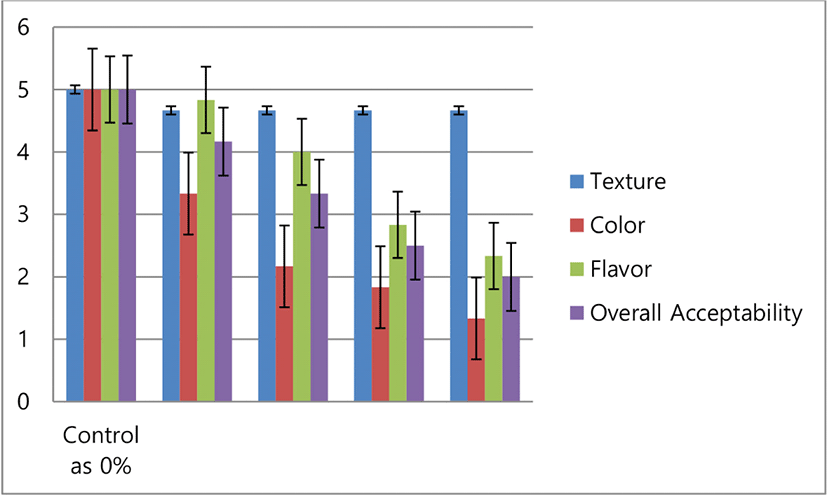
On the basis of the statistical analysis of the sensory evaluation assessment of almond milk obtained in this study, there was the statistically significant difference observed between the treated group and the control group in color, flavor, and overall acceptability except texture (p<0.05). When the addition amount of radish oil was increased, the point of sensory evaluation assessment of texture, color, flavor, and overall acceptability tended to decrease (Fig. 2). The almond milk contained with 0.5% of radish oil displayed a good trend compared with control group in this study.
Fig. 3 displayed the point of sensory evaluation assessment of oat milk evaluated by seven panels. Oat milk was contained with different concentrations (contained with 0.5% increments from 0% up to 2%) of radish oil. When radish oil was contained with oat milk from 0.5% to 2%, the point of texture ranged from 4.7 to 4.7, the point of color ranged from 3.0 to 1.2, the point of flavor ranged from 4.5 to 2.2, and the point of overall acceptability ranged from 4.7 to 2.0, which was lower than 5 of the control group (Fig. 3).
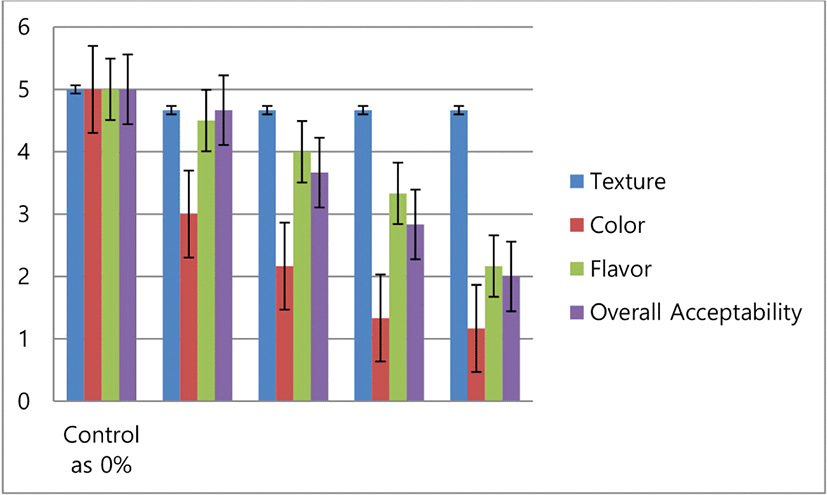
On the basis of the statistical analysis of the sensory evaluation assessment of oat milk obtained in this study, there was the statistically significant difference observed between the treated group and the control group in color, flavor, and overall acceptability except texture (p<0.05). When the addition amount of radish oil was increased, the point of sensory evaluation assessment of texture, color, flavor, and overall acceptability tended to decrease (Fig. 3). The oat milk contained with 0.5% of radish oil displayed a good trend compared with control group in this study.
Fig. 4 displayed the point of sensory evaluation assessment of soy milk evaluated by seven panels. Soy milk was contained with different concentrations (contained with 0.5% increments from 0% up to 2%) of radish oil. When radish oil was contained with soy milk from 0.5% to 2%, the point of texture ranged from 5.0 to 4.7, the point of color ranged from 4.2 to 2.2, the point of flavor ranged from 4.8 to 2.8, and the point of overall acceptability ranged from 4.7 to 2.2, which was lower than 5 of the control group (Fig. 4).
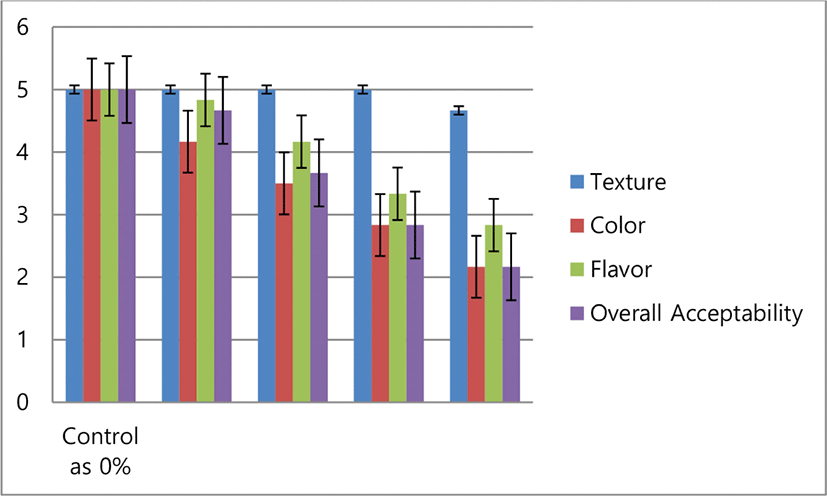
On the basis of the statistical analysis of the sensory evaluation assessment of soy milk obtained in this study, there was the statistically significant difference observed between the treated group and the control group in color, flavor, and overall acceptability except texture (p<0.05). When the addition amount of radish oil was increased, the point of sensory evaluation assessment of texture, color, flavor, and overall acceptability tended to decrease (Fig. 4). The soy milk contained with 0.5% of radish oil displayed a good trend compared with control group in this study.
Fig. 5 displayed the point of sensory evaluation assessment of Kefir evaluated by seven panels. Kefir was contained with different concentrations (contained with 0.5% increments from 0% up to 2%) of radish oil. When radish oil was contained with kefir from 0.5% to 2%, the point of texture ranged from 5.0 to 4.7, the point of color ranged from 4.5 to 3.2, the point of flavor ranged from 5.0 to 2.8, and the point of overall acceptability ranged from 5.0 to 2.7, which was lower than 5 of the control group (Fig. 5). But, the point of texture was very similar to that of the control group, and there was no statistically significant difference (p>0.05).
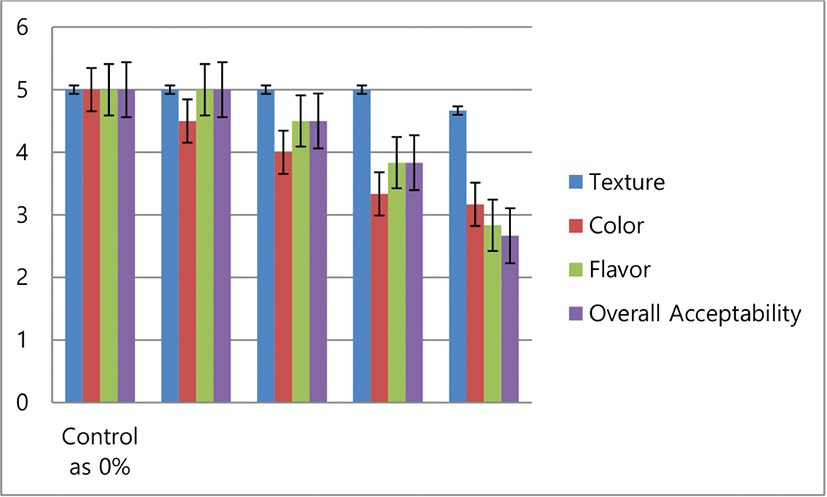
On the basis of the statistical analysis of the sensory evaluation assessment of Kefir obtained in this study, there was the statistically significant difference observed between the treated group and the control group in color, flavor, and overall acceptability except texture (p<0.05). When the addition amount of radish oil was increased, the point of sensory evaluation assessment of texture, color, flavor, and overall acceptability tended to decrease (Fig. 5). The Kefir added with 0.5% of radish oil displayed a good trend compared with control group in this study.
Fig. 6 displayed the point of sensory evaluation assessment of yoghurt evaluated by seven panels. Yoghurt was contained with different concentrations (contained with 0.5% increments from 0% up to 2%) of radish oil. When radish oil was contained with yoghurt from 0.5% to 2%, the point of texture ranged from 5.0 to 4.7, the point of color ranged from 5.0 to 4.0, the point of flavor ranged from 4.0 to 2.2, and the point of overall acceptability ranged from 4.3 to 1.7, which was generally lower than 5.0 of the control group (Fig. 6). But, the point of texture was very similar to that of the control group, and there was no statistically significant difference (p>0.05).
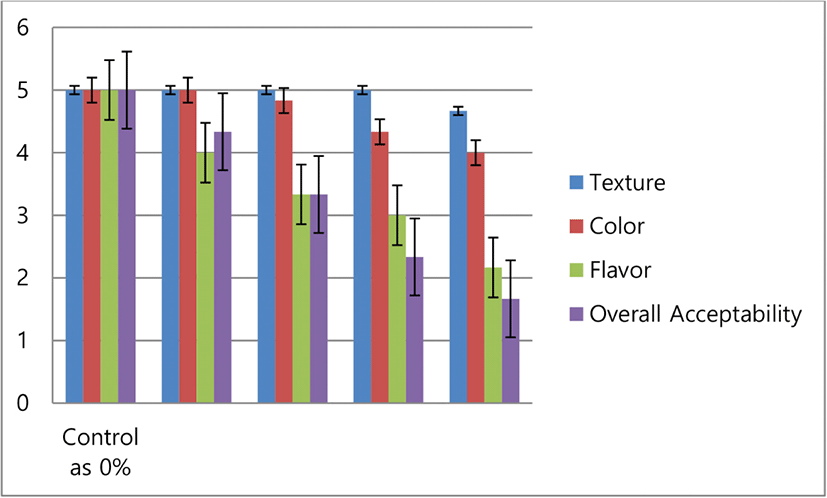
On the basis of the statistical analysis of the sensory evaluation assessment of yoghurt obtained in this study, there was the statistically significant difference observed between the treated group and the control group in color, flavor, and overall acceptability except texture (p<0.05). When the addition amount of radish oil was increased, the point of sensory evaluation assessment of color, flavor, and overall acceptability tended to decrease except texture (Fig. 6). The yoghurt contained with 0.5% of radish oil displayed a good trend compared with control group in this study.
Fig. 7 displayed the point of sensory evaluation assessment of cow milk evaluated by seven panels. Cow milk was contained with different concentrations (contained with 0.5% increments from 0% up to 2%) of radish oil. When radish oil was contained with cow milk from 0.5% to 2%, the point of texture ranged from 4.8 to 4.2, the point of color ranged from 3.7 to 1.2, the point of flavor ranged from 3.2 to 1.7, and the point of overall acceptability ranged from 3.5 to 1.5, which was generally lower than 5.0 of the control group (Fig. 7).
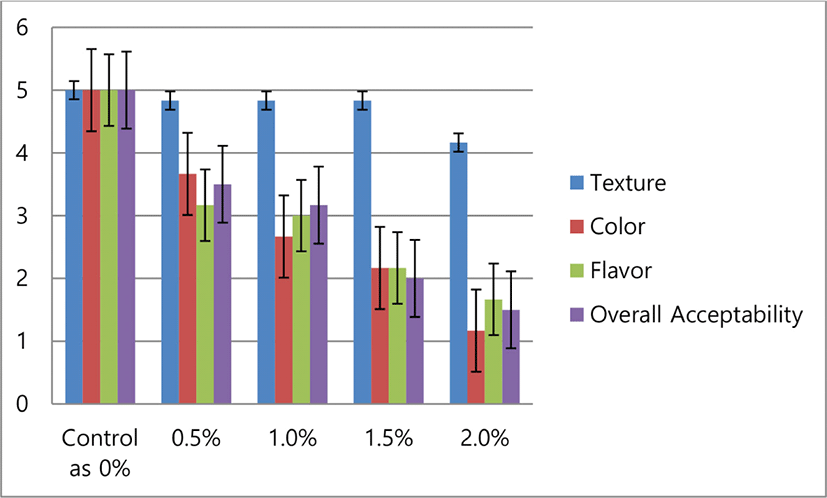
On the basis of the statistical analysis of the sensory evaluation assessment of cow milk obtained in this study, there was the statistically significant difference observed between the treated group and the control group in texture, color, flavor, and overall acceptability (p<0.05). When the addition amount of radish oil was increased, the point of sensory evaluation assessment of texture, color, flavor, and overall acceptability tended to decrease (Fig. 7). The cow milk contained with 0.5% of radish oil displayed a good trend compared with control group in this study.
pH of almond milk, oat milk, soy milk (nondairy products) and Kefir, yoghurt, cow milk (dairy products) without contained with radish oil was 6.77, 4.24, 4.37, 6.77, 7.51, and 8.52, respectively (Fig. 8). pH of radish oil was approximately 3.3 (data not shown). And pH of almond milk, oat milk, soy milk (nondairy products) and Kefir, yoghurt, cow milk (dairy products) contained with different concentrations (contained with 0.5% increments from 0% up to 2%) of radish oil displayed similar to that of almond milk, oat milk, soy milk (nondairy products) and Kefir, yoghurt, cow milk (dairy products) with no addition of radish oil in this study (Fig. 8). Hence, there was no statistically significant difference observed between the treated group and the control group in pH.
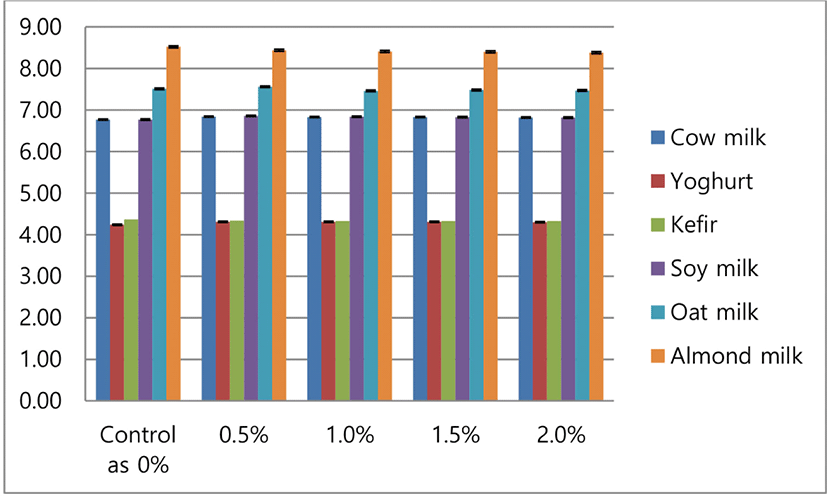
In pH, no statistically significant differences was observed in contained with various vegetable oils to dairy or non-dairy products [13]. pH displayed a similar trend in this study.
Also, Fig. 9 displayed color-change process in almond milk, oat milk, soy milk (nondairy products) and Kefir, yoghurt, cow milk (dairy products) contained with different concentrations of radish oil. In this study, almond milk, oat milk, soy milk (nondairy products) and Kefir, yoghurt, cow milk (dairy products) contained with different concentrations (contained with 0.5% increments from 0% up to 2%) of radish oil were observed to change to a very strong yellow color (Fig. 9). Hence, in the sensory evaluation assessment of almond milk, oat milk, soy milk (nondairy products) and Kefir, yoghurt, cow milk (dairy products) to which radish oil was contained, the point of color displayed a tendency to decrease a lot (Fig. 3–8).
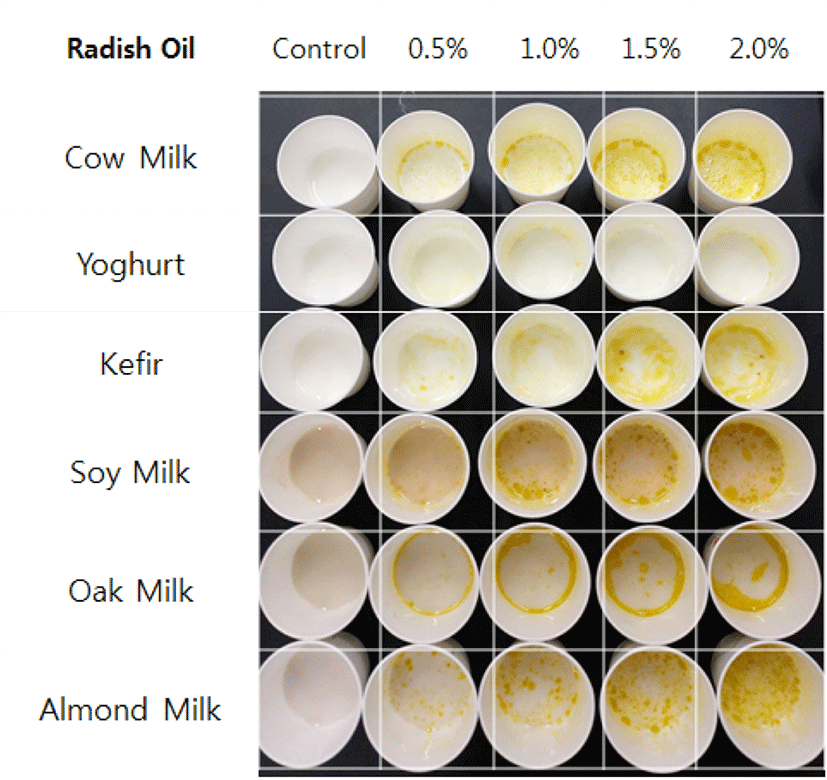
It is known that radish seeds (Raphanus sativus L.) included alkaloids which was anthocyanins, coumarins, flavonoids, saponins, and so on [14]. This could decrease the degree of uric acid in blood [15]. These mechanisms have been found to be related to circulating markers of inflammation and free radical responses [15]. Anthocyanins are known as an essential group of nutritional antioxidants with physiological multifunctions [16]. For this reason, they could help prohibit disease and also keep living cells from oxidative damage [16]. It is known that radish seeds have isothiocyanate, which could show anti-atherosclerotic, anti-bacterial, and anti-mutagenic effects [17]. Also, milk could inhibit degrading the isothiocyanate of Raphanus sativus L. (radish) and also activate the absorption of isothiocyanate in rats [18]. Based on these previous studies, research on the application of radish oil to various foods should be actively conducted in the future.
Conclusionally, the sensory evaluation assessment obtained in this study is summarized as follows. Especially, owing to strong yellow-color and the strong aroma of radish oil, the overall point displayed a tendency to be very low on increasing the contained concentration of radish oil to almond milk, oat milk, soy milk (nondairy products) and Kefir, yoghurt, cow milk (dairy products).
In addition, the various opinions of the evaluators who participated in this study are detailed below. When 1% or more of radish oil was added, it was somewhat difficult to consume due to the strong pungent taste and aroma of radish oil. When radish oil was added to almond milk, the flavor of almond milk was good, but the overall balance of the sensory test was somewhat insufficient. When radish oil was added to oat milk, the characteristic flavor of oat milk was better expressed. This trend was also observed in soy milk. In non-dairy products such as soymilk, oat, and almond, it was confirmed that it was generally well matched with vegetable flavor such as radish oil. Next, when radish oil was added to Kefir, it harmonized well with the sweet, sour, and flavor of kefir, resulting in a good overall flavor. However, in milk and fermented milk, it did not go well with radish oil. In particular, because of the strong flavor and oil properties unique to radish oil, the flavor of milk was impaired and the consistency of taste was not observed.
Additional studies are needed to evaluate the sensory evaluation assessment while subdividing the concentration of radish oil to less than 0.5%. Furthermore, it is also necessary to study the various biofunctional activities that can be expressed when radish oil is added to dairy or non-dairy products.

